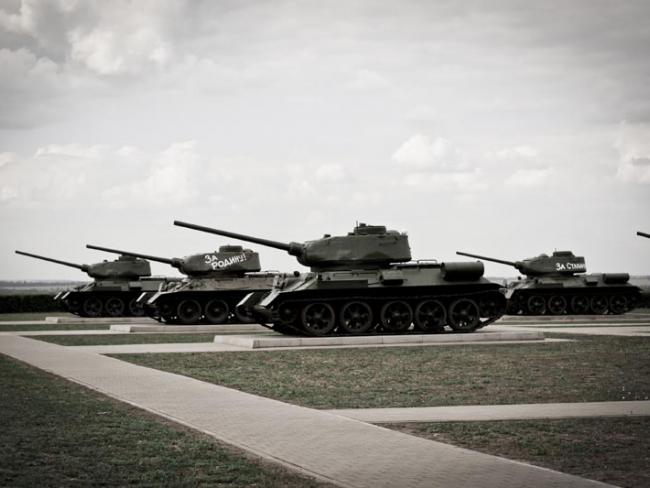
T-34 monument at Prokhorovka, site of the Battle of Prokhorovka, a major armoured confrontation during the Battle of Kursk. Photo Alexander Persona Grata, CC BY 2.0
Eighty years ago, the greatest land and tank battle ever was fought at Kursk, one from which the invading Nazi forces never recovered…
Raging ferociously from July to August 1943, Kursk was the most decisive battle of the Second World War. It transformed anti-fascist fortunes.
By 1943 fascist Germany had been drawn into a protracted war completely at odds with its preferred military strategy. Even worse, it had also been dragged into a protracted industrial and economic contest that it was losing.
The growing disparity in the capacity of Germany and the Soviet Union to produce the means to wage war meant that the Soviet Union had attained superiority in military hardware, and the gap was widening.
After the Soviet victory at Stalingrad in February 1943, fighting paused as both combatants regrouped. Both sides were planning for the next conflict, but the Soviet plans were better and more feasible.
Both sides realised that the summer of 1943 would see a monumental clash of arms, because Soviet forces were gaining military confidence and offensive capability whereas Hitlerite Germany had to muster a territorial gain to deter Soviet advance or they would be forced into more retreats.
Blitzkrieg
So in March 1943 Hitler and his generals planned a summer offensive, codenamed Operation Citadel, along classic blitzkrieg lines. The aim was to remove the Kursk Salient, a vulnerable 250 mile-long front jutting out beyond Soviet lines.
Using detailed intelligence reports of these intentions, the Soviet leadership decided not to make a pre-emptive strike beforehand but rather to “meet the enemy attack in a well-prepared defensive bridgehead, to bleed attacking German groupings dry, and then to launch a general offensive”.
They packed the salient with tanks and troops who dug in deeply and created a fortress. The plan was to draw the German Army in to a carefully devised trap, destroy much of its armoured power, and then launch a major strategic offensive.
To counter the panzer tank and dive-bomber attacks, extensive Soviet defences were constructed in great depth, hoping to snare the enemy in an intricate and extensive cobweb of defensive constructions.
More than 3,000 miles of trenches were dug, laid out in a crisscross pattern. Inside were deep and extensive entrenchments with strongly constructed anti-tank resistance points. Further defensive protection was provided by 500,000 anti-tank mines and 400,000 anti-personnel mines.
Importantly, there was a deeper-held reserve of supporting armies intended for decisive counterattacks when the advance stalled. The Soviet forces had over 1,900,000 men, close to double the strength of the German troops, tanks and aircraft and four times the number of guns and mortars.
All Soviet front line formations in the Kursk Salient received psychological as well as technical training to deal with the armoured threat and overcome the “tank panic” that had been in evidence since the German invasion began. Partisan forces had developed and were able to mount over 1,000 attacks against the railways in June.
Also the Soviet Union had developed its air force so that it might better compete with the Luftwaffe and provide a similar type of support for their own ground forces.
‘For the first time during summer conditions, the Soviet army out-performed their enemy…’
On the morning of 5 July the German offensive began with a 50-minute bombardment of Soviet positions. German artillery fired more shells than they had during the campaigns in France and Poland combined. But the Germans were forced to attack frontally rather than using their planned blitzkrieg tactics, and after several days of intense fighting, had made no significant breakthrough.
The Soviet defences were not breached. After 6 July the Luftwaffe was forced to prioritise air-support missions. It was unable to intercept all Soviet airstrikes and the balance of power in the air began shifting.
The German military machine, the Wehrmacht, was not used to this situation. The Soviets aimed to wear the enemy out as the Germans were hit hard at each defensive obstacle.
Dominance
The German army was contained. It could not make a breakthrough to Kursk, realising it probably never would. The Soviet air force was gaining dominance over the battle area too.
At this juncture the Soviet Supreme Commander Stalin conferred with Zhukov, his Deputy. They directed a planned offensive against the German-held Orel salient on the 12 July. A colossal battle took place lasting until the next day.
This time the Soviets were doing the attacking. On 13 July Hitler discontinued Operation Citadel in the north of the Kursk salient, although prolonging it in the south to prevent a rapid rout.
The Soviets fed fresher divisions into the fray at this point, while the Germans had no reserves to call upon. Their attacks began to peter out and the German army withdrew from or were forced out of the salient.
German losses of manpower and armoured fighting vehicles at Kursk meant the Wehrmacht could not resist the Soviet counterattacks during July and August. For the first time during summer conditions, the Soviet army outperformed their enemy.
But victory came at a huge cost. Soviet casualties reached 177,847 during the battle of Kursk.
The Battle of Kursk stripped the last vestiges of invincibility from the Wehrmacht. Nazi Germany was ruined on the Eastern Front. It never recovered.
Wartime prime minister Winston Churchill summed it up: “Stalingrad was the end of the beginning, but the Battle of Kursk was the beginning of the end.”
• A longer version of this article is on the web at www.cpbml.org.uk.
